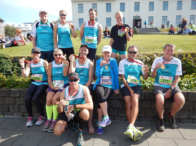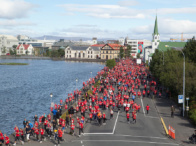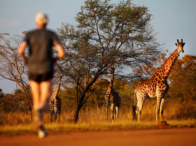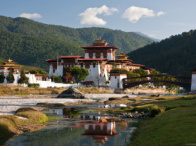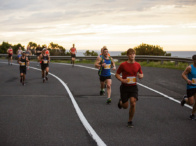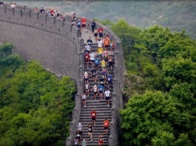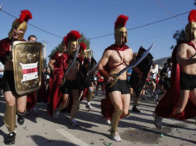I have wanted to visit Japan since the age of 18. On 22 February 2015, at a little over the age of 18, I even ran the Tokyo marathon to make it seem (in some perverse way) more decent…. or something. It was so, so, so, worth it.
I would do it again, in a heartbeat! My good friend and travelling companion, Jodie & I had a ball. At the end of our all-too-brief time in Japan, at Tokyo’s massive Shinjuku subway station (boasting over 200 exits, used by over 3 million commuters per day), hurrying to board the Narita Express to catch Sydney-bound QF22, I threw a little tantrum. With my wheelie suitcase behind me, I suddenly stood still, stomped my feet on the ground, pouting: “Jodie, I don’t want to go home! I want to stay in Japan!”
We had such a great time: Jodie is a superb Japan tour guide and a wonderful, highly organised and efficient person (but, then, that’s old news…). She takes advantage of the opportunities which life offers her. She will also devote heaps of ‘can do’ energy to making opportunities happen. Most importantly, however, as we both sleep very soundly, neither of us can confirm or deny the snoring allegations (which have been levelled at each of us). It doesn’t get much better than that!
I organised this marathon through that very fine travel agent, Travelling Fit of Terrigal (thank you, Felicity Kent and Mari-Mar Walton!). In about April 2014, when I said that I was planning to run Tokyo, Jodie (dog park mate: her schnauzer, Ruby and my border collie, Felix, are great mates), immediately offered to come. I did not fully appreciate then, my immense good fortune in having the benefit of Jodie along for a Japanese adventure. She’s lived in Tokyo with her clan (then 7 year old triplets) for 2 years, she has a solid command of Japanese and – critically – she is familiar with the Tokyo subway system. For one with my severely challenged sense of direction, this is a major bonus.
We stayed in the very massive Keio Plaza Hotel in the Shinjuku district (where most of the movie “Lost in Translation” was filmed) and ate thebest breakfasts! Thank goodness for Jodie’s familiarity with the Tokyo subway system. With its myriad of exits and three underground levels of platforms (gulp!), it was from Shinjuku station that we started all of our journeys. I love my Pasmo card!
Our first day was perfect: it was all new to me and Jodie had arranged beautiful weather. I was thoroughly delighted to wander around, visiting her former Tokyo neighbourhood haunts. A big focus for us both was the food in Japan; we ate supremely well. The gastronomic part of our adventure began with excellent coffee (Italian Segafreddo in Hiro-o) and nostalgic melon buns for Jodie from her much-frequented bakery, Kobeya Kitchen. We lunched at the modest, inexpensive but deeeeelicious ‘Soup Stock’. We spent quite some time in a totally crazy – only in Japan – store called ‘Tokyu Hands’. It is difficult to do it justice with words but suffice to say that we came close to buying something on every floor of that multi-level retail insanity (except the floor which sold pet mice)! After a tour of the spacious and classy Tokyo Lithuanian Embassy in Minato-Ku, we were the dinner guests of the very fine, diligently solicitous and generous Egidijus Meilūnas, the Lithuanian Ambassador to Australia & NZ, his totally charming, considerate and multi-lingual wife, Galina and Inga Miškinytė, the attaché to the Embassy, very lovely and every bit equally as charming and, naturally, also multi-lingual. We had a perfectly lovely evening, most interesting conversation. I had the first of several Japanese lessons.
Day two saw us at the busy, bustling, exciting and awesome Tsukiji Fish Markets. We ate monster-sized bar-b-qued scallops in their shells, sampled all sorts of things (not being always 100% sure, what they exactly were in each and every case) and did some great shopping. Next stop was the Tokyo Marathon Expo over the Rainbow Bridge at Ariake in the Odaiba district (think: Sydney’s Darling Harbour on steroids). As with all WMM Expos, it was massive, including uncharacteristically ‘in your face’ marketing from the Japanese. A ‘heads up’ for anyone wanting to buy Tokyo marathon Expo gear in western sizes: go to the Expo early on Day 1 as they sell out of ‘western size’ shoes and caps (the Japanese typically have small feet and quite large heads). The 2015 Tokyo marathon edition of Kayano 21s is fluoro yellow, complete with a course map on the inner sole (love that!). They had run out of my size by the morning of day 2, but, happily, it’s not as though I’m short of running shoes.
At the Tokyo Expo, the World Marathon Majors (“WMM”) Series proudly promoted its new name sponsor, Abbott, an Illinois-based global healthcare company. Abbott is the first WMM title sponsor. For those not in the know, WMM is a partnership of the Tokyo, Boston, London, Berlin, Chicago and New York City marathons. It is a sterling example of very inventive and, I imagine, highly successful marketing. Abbott’s sponsorship’s motto is: “Life … to the fullest.” Abbott came on board in 2015, introducing a slightly re-vamped format for the series.
The most off-beat Tokyo Expo display was devoted to proclaiming the virtues of the humble tomato as runners’ super food. Naturally, this included Japanese dressed as huge tomatoes. Of course, tomatoes, alongside bananas, were available at food stations on race day!
Other highlights included: a visit to the architecturally truly stunning Tokyo National Art Centre at Roppongi in the Minato district, selective shopping (very cool paper shops, quirky odds & ends shops), uber-good bargains, at Kabukiza Theatre, we saw Japanese Kabuki theatre (traditional, culturally significant and very, very well-executed, but thank heavens for the English translation on the hired headset earphones), enjoyed a pre-race pasta/pizza/rice carbo-loading dinner with Travelling Fit runners (incl a Kiwi runner who ran Tokyo as his 147th marathon!) – lots of fun, met Rob de Castella and his Indigenous Marathon Project runners (more about them later!), I ran a pretty damn good marathon on the cleanest, tidiest and most well-oiled course, EVER (more below), we had post-race drinks with the runners in the …ahem….rather pricey Polestar bar on the 46th floor of the Keio Plaza Hotel. Of course, as I have come to expect, we met another charming Strider, Dave Hazelwood, who ran a scorcher (3:08). Some pretty fast Tokyo 2015 times were posted by the Travelling Fit mob!
It was Jodie who spotted Rob de Castella on our Tokyo-bound flight. We next saw him, together with runners from his Indigenous Marathon Project (“IMP”) at the luggage carousel and at the hotel, at breakfast and at the expo. I recognised one of Deek’s IMP runners from the ABC documentary a few years ago. Charlie, I’m guessing, is in his late 20’s. He had run New York as his first marathon with Deek’s coaching and got to the Tokyo start line with a 3:22 PB. I had asked Charlie about his race plan for Tokyo. His very sage and positive response: “To feel good at 30K”. Happily, Charlie was generous enough to allow me to use that as my race plan, also. I embraced it and thought about it a lot in the days before the race. I attribute my pleasing Tokyo result to that positive thinking.
I recommend Tokyo as a fast course, very flat but with uphills in the last 5K (not very friendly). Be warned: late February Tokyo weather is likely to be cool! Finding one’s way to the start corrals was a bit chaotic, but, once inside, it was seamlessly organised; the course was, hands-down, the cleanest, tidiest, close to totally rubbish-free experience! AMAZING! No crunching of drink cups underfoot at drink stations in Tokyo, no way, no siree! Arigato! Gambatte to all runners!!
The course is very much in metropolitan Tokyo. For Tokyophiles: Marathoners start in Shinjuku at the Tokyo Metropolitan Government Office Buildings heading due east; at 5K, run north to Kagurazaka, then south-east past the Imperial Palace Gardens (very easy on the eye!); at 10K, they turn due south and run 5K to Shinagawa; turn back and run along the other side of the road back to Hibiya (21.1K mark); at Ginza, they turn north-east and run to Azumabashi (just past 27K), then back to Ginza (again, on the other side of the road), pass the Kabukiza Theatre at 35K and, with the Tsukiji Fish Markets on the right of the course, continue over four – mercifully short – bridges (none of which seemed to me to have a compensatory downhill portion for the initial uphill!) called ‘Tsukudaohashi’, ‘Asashioohashi’, ‘Harumbashi’ and ‘Shinonomebashi’, finishing in Ariake at the Tokyo Big Sight, with the ‘Tokyo Rinkai Disaster Prevention Park’ at the 41.5K section of the course…. It is a very, very well-planned course; every bit as well-supported in terms of first aid, water/sports drink, nutrition options (including tomatoes) and thousands of happy, cheerful, most enthusiastic, hard-working and diligent volunteers, as are all WMM events, but much, much, cleaner. There were also 28 “events” along the course, ie, entertainment to distract runners, such as the Japan Ground Self-Defence Force Band, plenty of Japanese folk dancing in traditional dress, the Imperial Guard Band, hula dancing, four taiko drum displays, the Tokyo Fire Department Band and portable shrines. They provide lots to consider other than one’s pace and the fact that stopping for a break would be rather nice!
I have some community service bulletins for the first-time Tokyo runner, here is one: The ‘A’ start group, contrary to what one might expect, is not, repeat, not all the uber-fast runners. The ‘A’ pack is at the front of the 36,000 entrants, just behind the invited, predominantly East African gazelles. While there are some very quick runners indeed in the “A” start corral, it is simply reserved for members of the Japanese Athletic Federation. So, along with the sub-2:30 pack, are those dressed as Minnie Mouse, edamame beans, sumo wrestlers, super heroes, toasters, sushi rolls, Elvis Presleys etc, etc. One needs to negotiate this mob, lucky it’s – somewhat and for the most part – entertaining. The stand-out dress-up (see Jodie’s photo at 35K): a runner dressed in a single-shouldered leopard skin print caveman mini-dress, a black ‘afro’ style wig, carrying a stuffed toy patagosaurus (about 600mm long!). His timing chip was on an anklet because he ran in pink thongs on his feet; at 35K, he was at 3:30 pace!
In response to terrorism concerns, over 60 Tokyo running police, wearing white ‘POLICE’ vests, contributed to ensuring a safe marathon, running about 10K each and carrying anti-terrorism gear in small backpacks. There were also heaps of runners wearing ‘DOCTOR’ vests, as well as quite a few on bicycles, just scoping out the crowd. This was in addition to serious-looking medical aid tents starting at 5K, and every 5K thereafter.
But perhaps the single most distinctive feature of this marathon was the unbelievable cleanliness of the course. With over 15 million people living in Tokyo metro area alone, it is one amazingly clean & tidy city. Nevertheless, to carry that over into a marathon in which some 36,000 runners take to the streets with their gels, water & sports drink cups and keep it rubbish-free, by which I mean spotlessly tidy, during a race, is an incredible achievement. In Tokyo, there were gazillions of volunteers, all members of a squad called ‘Team Smile’. They were amazingly supportive and enthusiastic, clapping their white-gloved hands incessantly, shouting “Gambatte!” to all runners. They wore black pants, white gloves, a regulation shirt covered by a loose smock, proclaiming …you guessed it….’Team Smile’. Most of the sports drink and water stations (of which there were 15 on the course) consisted of at least 10 tables, punctuated by three massive rubbish boxes in between each of the tables. Each table was supremely well-staffed by white-gloved Team Smilers. There were – literally – thousands of them. Team Smilers held plastic bags open for runners’ rubbish; at many stretches, they were ‘on duty’ every 20 metres or so. If a runner’s aim happened to miss a rubbish bag, a Team Smiler promptly darted out onto the course to whisk it up. Naturally, most of the Japanese competitors ran over to the rubbish bags and placed their rubbish into the rubbish bags. That is, after all, where rubbish belongs!
It is my practice to regularly, frequently, audibly and as enthusiastically as I can, thank volunteers in the races which I run, especially marathons. These events simply would not work without them. My race plan includes the kissing of at least one volunteer during a race. In Tokyo, I was feeling very good at the 15K mark, so I ran right up to a Team Smiler and as he took a rather startled backwards step, I grabbed the poor fellow by both shoulders and after repeating “Arigato Gozaimashita!” (“Thank you very much!”), I fairly lunged at him, planting a sweaty kiss on each of his cheeks. The initial horror of his fellow Team Smilers very rapidly turned to smiling, nodding, giggling and staccato-clapping encouragement.
I was to have met the Lithuanian embassy contingent at 21.1 (reached in 1:45) but sadly, that plan did not come to pass; too much congestion. I re-calibrated (love a good re-calibration!) and, having felt good at 30K (Thank you, Charlie!), shifted focus to anticipating seeing Jodie at 35 K…. and I did! She was resplendent in the fluoro pink Tokyo marathon shirt which we had agreed that she wear (for ease of spotting her in the throng), shouting “Ginta! I’m here! I’m here!”. I ran over to her, we shared a particularly smelly hug, proclaimed our love for one another and, as her trembling hands peeled the banana which I had requested, she dropped it! Never mind, she had Plan B (banana #2) but that didn’t stop me bending down to pick it up, nearly seizing up in the quad muscle department. Nevertheless, onward: still 7.195K to go.
By the 35K stage of the race, I found it mentally more straightforward and appealing to approach each K on a stand-alone basis. I did not check my time at all for the last 5K; I had simply resolved to run each individual K as fast as possible. It sounds weird, but I drew strength from the fact that I had felt good at 30K. Every K after 37.195K, there was a sign proclaiming “5K TO GO”, “4K TO GO” and so on. At the 42 K mark, with only that last, veeeeerrrrrry long 195 m left, and with the massive finish gate in plain sight, there is a mock finish gate, proclaiming, in HUGE FONT, the very welcome message: “LAST 195”. Terrifically motivational. It certainly seems as though this course was designed by a committee of very experienced marathoners. I know we were all shuffling by that point, but in our own deluded and unhinged minds, we each looked like Usain Bolt in an Olympic final! When I saw my time was 3:43, I cried….my second-fastest marathon result ever and I have now completed the WMM series. (No, I do not now propose to take up on-line chess!)
Because I know how runners love stats, the hard facts, according to Tokyo Marathon website:
My net time: 3:43:15
6,437th out of 34,063 finishers overall
360th out of 2,513 55-59 y/o runner finishers
749th out of 7,227 female finishers (not too sure about this statistic…)
61st out of 181 Australian finishers
Charlie ran 2:56.
On our last day in Japan, following Jodie’s inspired plan, we caught the Shinkansen (bullet train) to Karuizawa and had an outdoor onsen in the snow (!) at Hoshino. We had one of the very best meals of our lives at ‘Kawakami’, a little café in Karuizawa… our few days were just so jam-packed and wonderful! I love Japan.
Ginta Viliunas
Tokyo marathon 2015
Bib number E85231






